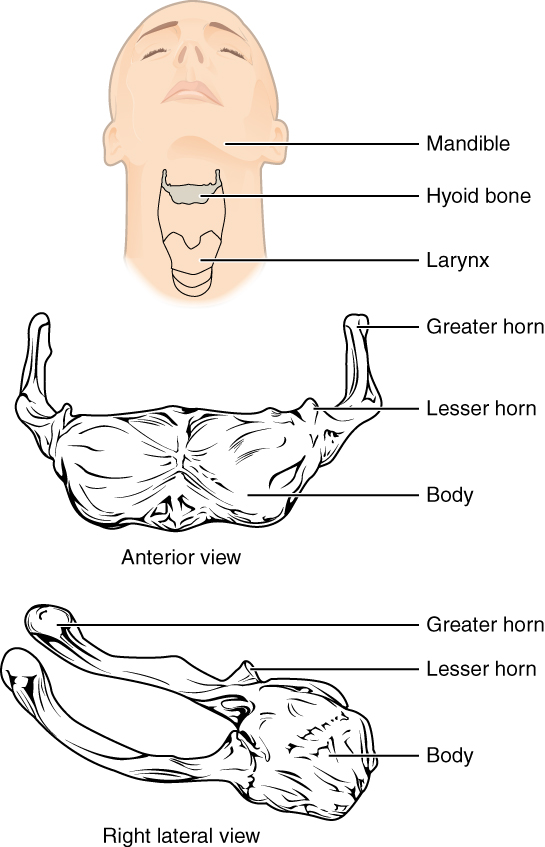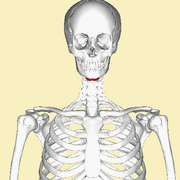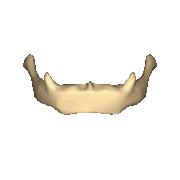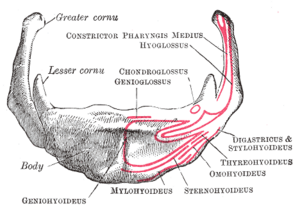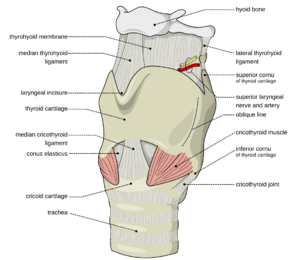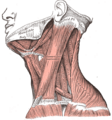Hyoid bone facts for kids
| Bone: Hyoid | ||
|---|---|---|
| The hyoid bone, present at the front of the neck, has a body and two sets of horns | ||
| Latin | os hyoideum | |
| Precursor | Second and third branchial arch | |
The hyoid bone is a special bone found in the front of your neck, right between your chin and your voice box (larynx). It's shaped a bit like a horseshoe. When you're resting, it sits between your jawbone and the third bone in your neck (a cervical vertebra).
What makes the hyoid bone so unique? Unlike almost every other bone in your body, it doesn't directly connect to any other bones! Instead, it's held in place by muscles and tough tissues called ligaments. These muscles pull on the hyoid bone from the front, back, and bottom. This special setup helps your tongue move and allows you to swallow food and drinks. The hyoid bone also provides a place for muscles of your mouth, tongue, and throat to attach.
Its name comes from an ancient Greek word, hyoeides, which means "shaped like the letter upsilon (υ)".
Contents
What is the Hyoid Bone Like?
The hyoid bone is considered an irregular bone because it doesn't have a simple shape like a long bone or a flat bone. It has a main central part called the body. From the body, two pairs of parts stick out, like horns on an animal. These are called the greater horns and the lesser horns.
The Body of the Hyoid Bone
The body is the central and largest part of the hyoid bone.
- The front surface of the body curves outwards and faces forward and slightly upwards.
- It has a noticeable ridge across its upper half.
- Many muscles attach to the front of the body, helping with tongue movement and swallowing.
- The back surface is smooth and curves inwards, facing backward and downwards.
- The top and bottom surfaces also provide attachment points for various muscles.
The Horns of the Hyoid Bone
The "horns" are two sections of bone that stick out from each side of the hyoid body.
Greater Horns
The greater horns are the larger pair. They extend backward from the outer edges of the body. They are somewhat flat and get narrower towards their ends. Many important muscles attach to these horns, including those that help you move your tongue and swallow.
Lesser Horns
The lesser horns are smaller and shaped like tiny cones. They are attached to the points where the body and the greater horns meet. These small horns are connected to the main bone by tough, flexible tissue. Sometimes, as people get older, these connections can become solid bone. The tip of each lesser horn is where a ligament called the stylohyoid ligament attaches.
How the Hyoid Bone Develops
The hyoid bone starts to form from special structures in a developing baby called pharyngeal arches. The second pharyngeal arch helps form the lesser horns and the upper part of the hyoid body. The third pharyngeal arch forms the greater horns and the lower part of the body.
The hyoid bone hardens (ossifies) from six different spots. The greater horns start to harden first, even before birth. The body hardens shortly after, and the lesser horns harden during the first year or two after a baby is born. For a long time, the connections between the body and the greater horns are flexible, made of connective tissue. But usually, by middle age, these connections become solid bone.
Blood Supply to the Hyoid Bone
The hyoid bone gets its blood supply from the lingual artery. This artery runs down from your tongue to the greater horns of the bone, bringing it the nutrients and oxygen it needs.
What Does the Hyoid Bone Do?
The hyoid bone is found in many mammals, not just humans. It plays a big role in allowing a wide range of movements for your tongue, throat (pharynx), and voice box (larynx). By holding these parts in place, it helps you make many different sounds and speak.
Scientists once thought that the position of the hyoid bone was the main reason humans could speak so well. However, we now know that other animals, like Neanderthals, also had a similar hyoid bone, suggesting they might have had speech abilities too.
Recent studies also show that the hyoid bone is very important for swallowing. It's believed that this bone developed in mammals along with the ability for babies to drink milk from their mothers.
Muscles Connected to the Hyoid Bone
Many muscles attach to the hyoid bone, helping it perform its important jobs. These muscles are grouped by whether they are above or below the hyoid bone:
- Muscles above the hyoid: These muscles help lift the hyoid bone and move the tongue. Examples include the digastric muscle, stylohyoid muscle, geniohyoid muscle, and mylohyoid muscle.
- Muscles below the hyoid: These muscles help pull the hyoid bone down and move the voice box. Examples include the thyrohyoid muscle, omohyoid muscle, and sternohyoid muscle.
-
Muscles of the neck. Lateral view.
Why is the Hyoid Bone Important for Health?
The hyoid bone is crucial for several body functions, including breathing, swallowing, and speaking. It also helps keep your upper airway open while you sleep. This is important because if the airway collapses during sleep, it can lead to a condition called obstructive sleep apnea (OSA), where breathing stops and starts repeatedly. Studies have shown that if the hyoid bone is positioned lower in the neck, it can be linked to OSA.
Sometimes, doctors might perform a surgery called hyoid suspension to try and improve the airway for people with OSA.
Because of its protected position in the neck, the hyoid bone doesn't break easily. In children and teenagers, whose bones are still growing and more flexible, it's even harder for the hyoid bone to fracture, even after a serious injury.
The Hyoid Bone in Other Animals
The hyoid bone in animals comes from parts of their gill arches, which are structures found in fish. In many animals, it has more "horns" than humans do. For example, amphibians and some reptiles can have many horns, while birds usually have only one pair. In birds and some reptiles, the body of the hyoid bone is very long, providing strong support for their tongues.
- The howler monkey has a special hyoid bone that is hollow and filled with air. This helps them make their loud calls!
- In woodpeckers, the hyoid bone is super long. Its horns wrap all the way around the back of their skull. This acts like a natural helmet, protecting their brain from damage when they peck wood.
- In some mammals, the hyoid bone's structure can determine if they can roar. If the hyoid bone isn't fully hardened (like in lions), it allows them to roar, but they can't purr. If it's completely hardened (like in cheetahs or house cats), they can purr and meow, but they can't roar.
-
The hyoid bone of a gecko with attached tracheal rings
In veterinary medicine (animal doctors), the term "hyoid apparatus" is used to describe all the bones of the tongue together. In humans, our single hyoid bone is like the entire hyoid apparatus.
See also
 In Spanish: Hueso hioides para niños
In Spanish: Hueso hioides para niños
- Hyoid bone fracture
- Adam's apple


